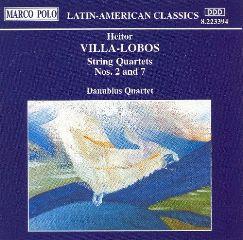Heitor Villa-Lobos - String Quartets Nos. 2 & 7 (1994)
Heitor Villa-Lobos - String Quartets Nos. 2 & 7 (1994)

String Quartet No. 2 1. Allegro non troppo 00:06:41 2. Scherzo: Allegro 00:03:47 3. Andante 00:03:51 4. Allegro deciso - Presto - Prestissimo final 00:07:54 String Quartet No. 7 5. Allegro 00:11:36 6. Andante 00:08:10 7. Scherzo: Allegro vivace 00:07:33 8. Allegro giusto 00:10:48 Danubius Quartet: Judit Tóth – 1st violin Adél Miklós – 2nd violin Cecilia Bodolai - viola Ilona Wibl – cello
"I love to write quartets. One could say that it is a mania." Villa-Lobos made his confession, quoted by Pierre Vidal, in Paris in the spring of 1958. He had completed his seventeenth and final quartet the year before and had begun to sketch an eighteenth. It is usual to think of Villa-Lobos's prodigious output in orchestral terms, and it may come as a surprise that chamber music forms a substantial part of his work. Of that chamber music string quartets are by far the major constituent, and within the broader context of the twentieth-century string quartet, dominated by Bartók and Shostakovich, Villa-Lobos's seventeen quartets must be considered a significant, though poorly acknowledged, contribution.
Composed in 1915 and first performed two years later, String Quartet No. 2 could scarcely be more different from the first quartet, and the fact that both were written in the same year makes the contrast all the more startling. In his study of Villa-Lobos's quartets Arnaldo Estrella proposes that the leap from the first to the second quartet cannot be thought of as an evolutionary one but as a complete rupture or perhaps a rebeginning. During the First World War the poet Paul Claudel came to Brazil as the French ambassador, and he brought Darius Milhaud with him as a cultural aide. Milhaud brought the latest musical advances from Europe, including bitonality and atonality, and Villa-Lobos embraced those new techniques enthusiastically, finding that they resonated with his own aspirations for freedom and innovation.
Composed in 1942 and dedicated to the Borgerth Quartet, who first performed tin 1945, the seventh is the largest and most difficult of Villa-Lobos's quartets, lasting 38 minutes. The customary use of imitation and its attendant polyphony are in large part absent, replaced by long passages of transcendental virtuosity for all four instruments. There are no key signatures, but various tonalities, especially C major, affirm themselves, creating the feeling that Villa-Lobos is only flirting with the atonality that was to emerge fully in the eighth quartet. --- David Nelson, naxos.com
download (mp3 @320 kbs):
yandex 4shared mega mediafire cloudmailru uplea ge.tt
Last Updated (Friday, 21 October 2016 16:46)
